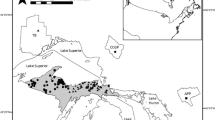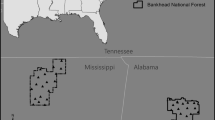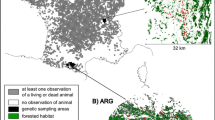Abstract
Context
Dispersal is essential for species persistence and landscape genetic studies are valuable tools for identifying potential barriers to dispersal. Macaws have been studied for decades in their natural habitat, but we still have no knowledge of how natural landscape features influence their dispersal.
Objectives
We tested for correlations between landscape resistance models and the current population genetic structure of macaws in continuous rainforest to explore natural barriers to their dispersal.
Methods
We studied scarlet macaws (Ara macao) over a 13,000 km2 area of continuous primary Amazon rainforest in south-eastern Peru. Using remote sensing imagery from the Carnegie Airborne Observatory, we constructed landscape resistance surfaces in CIRCUITSCAPE based on elevation, canopy height and above-ground carbon distribution. We then used individual- and population-level genetic analyses to examine which landscape features influenced gene flow (genetic distance between individuals and populations).
Results
Across the lowland rainforest we found limited population genetic differentiation. However, a population from an intermountain valley of the Andes (Candamo) showed detectable genetic differentiation from two other populations (Tambopata) located 20–60 km away (F ST = 0.008, P = 0.001–0.003). Landscape resistance models revealed that genetic distance between individuals was significantly positively related to elevation.
Conclusions
Our landscape resistance analysis suggests that mountain ridges between Candamo and Tambopata may limit gene flow in scarlet macaws. These results serve as baseline data for continued landscape studies of parrots, and will be useful for understanding the impacts of anthropogenic dispersal barriers in the future.


Similar content being viewed by others
References
Andrew RL, Bernatchez L, Bonin A, Buerkle CA, Carstens BC, Emerson BC, Garant D, Giraud T, Kane NC, Rogers SM, Slate J, Smith H, Sork VL, Stone GN, Vines TH, Waits L, Widmer A, Rieseberg LH (2013) A road map for molecular ecology. Mol Ecol 22(10):2605–2626
Andrew RL, Ostevik KL, Ebert DP, Rieseberg LH (2012) Adaptation with gene flow across the landscape in a dune sunflower. Mol Ecol 21(9):2078–2091
Asner GP, Knapp DE, Boardman J, Green RO, Kennedy-Bowdoin Ty, Eastwood M, Martin RE, Anderson C, Field CB (2012) Carnegie Airborne Observatory-2: increasing science data dimensionality via high-fidelity multi-sensor fusion. Remote Sens Environ 124:454–465
Asner GP, Knapp DE, Martin RE, Tupayachi R, Anderson CB, Mascaro J, Sinca F, Chadwick KD, Higgins M, Farfan W, Llactayo W, Silman MR (2014) Targeted carbon conservation at national scales with high-resolution monitoring. Proc Natl Acad Sci 111(47):E5016–E5022
Asner GP, Llactayo W, Tupayachi R, Luna ER (2013) Elevated rates of gold mining in the Amazon revealed through high-resolution monitoring. Proc Natl Acad Sci 110(46):18454–18459
Baraloto C, Alverga P, Quispe SB, Barnes G, Bejar Chura N, da Silva IB, Castro W, da Souza H, de Souza Moll IE, Del Alcazar Chilo J, Duenas Linares H, Quispe JG, Kenji D, Marsik M, Medeiros H, Murphy S, Rockwell C, Selaya G, Shenkin A, Silveira M, Southworth J, Vasquez Colomo GH, Perz S (2015) Effects of road infrastructure on forest value across a tri-national Amazonian frontier. Biol Conserv 191:674–681
Beheregaray LB, Caccone A (2007) Cryptic biodiversity in a changing world. J Biol 6(4):1–5
BirdLife International and NatureServe (2014) Bird species distribution maps of the world. Version 4.0. BirdLife International, Cambridge, UK and NatureServe, Arlington, USA.
Böhning-Gaese K, Caprano T, Van Ewijk K, Veith M (2006) Range size: disentangling current traits and phylogenetic and biogeographic factors. Am Nat 167(4):555–567
Brightsmith DJ (2004) Effects of weather on parrot geophagy in Tambopata, Peru. Wilson Bull 116:134–145
Brightsmith DJ (2005) Parrot nesting in Southeastern Peru: seasonal patterns and keystone trees. Wilson Bull 117:296–305
Brightsmith DJ, Hilburn J, del Campo A, Boyd J, Frisius M, Frisius R, Janik D, Guillen F (2005) The use of hand-raised psittacines for reintroduction: a case study of scarlet macaws (Ara macao) in Peru and Costa Rica. Biol Conserv 121:465–472
Britt CR, Anleu RG, Desmond MJ (2014) Nest survival of a long-lived psittacid: scarlet Macaws (Ara macao cyanoptera) in the Maya Biosphere Reserve of Guatemala and Chiquibul Forest of Belize. Condor 116(2):265–276
Clobert J, Baguette M, Benton TG, Bullock JM, Ducatez S (2012) Dispersal ecology and evolution. Oxford University Press, Oxford
Collar N, Boesman P, Sharpe CJ (2016) Scarlet Macaw (Ara macao). In: del Hoyo J, Elliott A, Sargatal J, Christie DA, de Juana E (eds) Handbook of the birds of the world alive. Lynx Edicions, Barcelona. http://www.hbw.com/node/54620. Accessed 4 Oct 2016
Conover T (2003) Perú’s long haul: highway to riches, or ruin? Natl Geogr 203:80–100
Cushman Samuel A, McKelvey Kevin S, Hayden J, Schwartz Michael K (2006) Gene flow in complex landscapes: testing multiple hypotheses with causal modeling. Am Nat 168(4):486–499
Dobson S (1982) Competition for mates and predominant juvenile male dispersal in mammals. Anim Behav 30(4):1183–1192
Earl D, vonHoldt B (2012) STRUCTURE HARVESTER: a website and program for visualizing STRUCTURE output and implementing the Evanno method. Conserv Genet Resour 4(2):359–361
Evanno G, Regnaut S, Goudet J (2005) Detecting the number of clusters of individuals using the software STRUCTURE: a simulation study. Mol Ecol 14(8):2611–2620
Excoffier L, Smouse PE, Quattro JM (1992) Analysis of molecular variance inferred from metric distances among DNA haplotypes: application to human mitochondrial DNA restriction data. Genetics 131(2):479–491
Falush D, Stephens M, Pritchard JK (2003) Inference of population structure using multilocus genotype data: linked loci and correlated allele frequencies. Genetics 164(4):1567–1587
Faria PJ, Guedes NMR, Yamashita C, Martuscelli P, Miyaki CY (2008) Genetic variation and population structure of the endangered Hyacinth Macaw (Anodorhynchus hyacinthinus): implications for conservation. Biodivers Conserv 17:765–779
Finer M, Jenkins CN, Pimm SL, Keane B, Ross C (2008) Oil and gas projects in the Western Amazon: threats to wilderness, biodiversity, and indigenous peoples. PLoS ONE 3(8):e2932
Forshaw JM (2011) Parrots of the world. CSIRO Publishing, Collingwood
Girardin CAJ, Malhi Y, AragÃO LEOC, Mamani M, Huaraca Huasco W, Durand L, Feeley KJ, Rapp J, Silva-Espejo JE, Silman M, Salinas N, Whittaker RJ (2010) Net primary productivity allocation and cycling of carbon along a tropical forest elevational transect in the Peruvian Andes. Glob Change Biol 16(12):3176–3192
Goslee SC, Urban DL (2007) The ecodist package for dissimilarity-based analysis of ecological data. J Stat Softw 22(7):1–19
Graves TA, Beier P, Royle JA (2013) Current approaches using genetic distances produce poor estimates of landscape resistance to interindividual dispersal. Mol Ecol 22(15):3888–3903
Guillot G, Estoup A, Mortier F, Cosson JF (2005) A spatial statistical model for landscape genetics. Genetics 170(3):1261–1280
Guillot G, Renaud S, Ledevin R, Michaux J, Claude J (2012) A unifying model for the analysis of phenotypic, genetic, and geographic data. Syst Biol 61(6):897–911
Guillot G, Rousset F (2013) Dismantling the Mantel tests. Methods Ecol Evol 4(4):336–344
Hanski I, Erälahti C, Kankare M, Ovaskainen O, Sirén H (2004) Variation in migration propensity among individuals maintained by landscape structure. Ecol Lett 7(10):958–966
IUCN (2014) The IUCN red list of threatened species. Version 2014.2. http://www.iucnredlist.org/
Keenan RJ, Reams GA, Achard F, de Freitas JV, Grainger A, Lindquist E (2015) Dynamics of global forest area: results from the FAO Global Forest Resources Assessment 2015. For Ecol Manag 352:9–20
Keller D, Holderegger R, van Strien M, Bolliger J (2015) How to make landscape genetics beneficial for conservation management? Conserv Genet 16(3):503–512
Kokko H, López-Sepulcre A (2006) From individual dispersal to species ranges: perspectives for a changing world. Science 313(5788):789–791
Lee ATK, Marsden SJ (2012) The influence of habitat, season, and detectability on abundance estimates across an Amazonian Parrot assemblage. Biotropica 44:537–544
Legendre P, Fortin M-J (2010) Comparison of the Mantel test and alternative approaches for detecting complex multivariate relationships in the spatial analysis of genetic data. Mol Ecol Resour 10(5):831–844
Legendre P, Lapointe F-J, Casgrain P (1994) Modeling brain evolution from behavior: a permutational regression approach. Evolution 48(5):1487–1499
Manel S, Holderegger R (2013) Ten years of landscape genetics. Trends Ecol Evol 28(10):614–621
Manel S, Schwartz MK, Luikart G, Taberlet P (2003) Landscape genetics: combining landscape ecology and population genetics. Trends Ecol Evol 18(4):189–197
McDougald D, Rice SA, Barraud N, Steinberg PD, Kjelleberg S (2012) Should we stay or should we go: mechanisms and ecological consequences for biofilm dispersal. Nat Rev Micro 10(1):39–50
McRae BH, Beier P (2007) Circuit theory predicts gene flow in plant and animal populations. Proc Natl Acad Sci 104(50):19885–19890
McRae BH, Shah VB, Mohapatra TK (2013) Circuitscape 4 user guide. The Nature Conservancy. http://www.circuitscape.org/
Monge O, Schmidt K, Vaughan C, Gutiérrez-Espeleta G (2016) Genetic patterns and conservation of the Scarlet Macaw (Ara macao) in Costa Rica. Conserv Genet 17:745–750
Munn CA (1992) Macaw biology and ecotourism, or “When a bird in the bush is worth two in the hand”. In: Beissinger SR, Snyder NFR, Munn CA (eds) New world parrots in crisis: solutions from conservation biology. Smithsonian Institution Press, Washington, DC, pp 47–72
Olah G, Heinsohn RG, Brightsmith DJ, Espinoza JR, Peakall R (2016) Validation of non-invasive genetic tagging in two large macaw species (Ara macao and A. chloropterus) of the Peruvian Amazon. Conserv Genet. doi:10.1007/s12686-016-0573-4
Olah G, Heinsohn RG, Espinoza JR, Brightsmith DJ, Peakall R (2015) An evaluation of primers for microsatellite markers in Scarlet Macaw (Ara macao) and their performance in a Peruvian wild population. Conserv Genet Resour 7(1):157–159
Olah G, Vigo G, Heinsohn R, Brightsmith DJ (2014) Nest site selection and efficacy of artificial nests for breeding success of Scarlet Macaws Ara macao macao in lowland Peru. J Nat Conserv 22(2):176–185
Olah G, Vigo G, Ortiz L, Rozsa L, Brightsmith DJ (2013) Philornis sp bot fly larvae in free living scarlet macaw nestlings and a new technique for their extraction. Vet Parasitol 196(1–2):245–249
Orsini L, Vanoverbeke J, Swillen I, Mergeay J, De Meester L (2013) Drivers of population genetic differentiation in the wild: isolation by dispersal limitation, isolation by adaptation and isolation by colonization. Mol Ecol 22(24):5983–5999
Peakall R, Ruibal M, Lindenmayer DB (2003) Spatial autocorrelation analysis offers new insights into gene flow in the Australian bush rat, Rattua Fuscipes. Evolution 57(5):1182–1195
Peakall R, Smouse PE (2006) GENALEX 6: genetic analysis in Excel. Population genetic software for teaching and research. Mol Ecol Notes 6(1):288–295
Peakall R, Smouse PE (2012) GenAlEx 6.5: genetic analysis in Excel. Population genetic software for teaching and research—an update. Bioinformatics 28(19):2537–2539
Peakall R, Smouse PE, Huff DR (1995) Evolutionary implications of allozyme and RAPD variation in diploid populations of dioecious buffalograss Buchloë dactyloides. Mol Ecol 4(2):135–148
Pritchard JK, Stephens M, Donnelly P (2000) Inference of population structure using multilocus genotype data. Genetics 155(2):945–959
R Core Team (2013) R: a language and environment for statistical computing. R Foundation for Statistical Computing, Vienna
Renton K, Brightsmith DJ (2009) Cavity use and reproductive success of nesting macaws in lowland forest of southeast Peru. J Field Ornithol 80:1–8
Schmidt KL (2013) Spatial and temporal patterns of genetic variation in scarlet macaws (Ara macao): implications for population management in La Selva Maya. Columbia University, Central America
Schofield G, Dimadi A, Fossette S, Katselidis KA, Koutsoubas D, Lilley MKS, Luckman A, Pantis JD, Karagouni AD, Hays GC (2013) Satellite tracking large numbers of individuals to infer population level dispersal and core areas for the protection of an endangered species. Divers Distrib 19(7):834–844
Segelbacher G, Cushman SA, Epperson BK, Fortin M-J, Francois O, Hardy OJ, Holderegger R, Taberlet P, Waits LP, Manel S (2010) Applications of landscape genetics in conservation biology: concepts and challenges. Conserv Genet 11(2):375–385
Shaw AK, Jalasvuori M, Kokko H (2014) Population-level consequences of risky dispersal. Oikos 123(8):1003–1013
Smith AL, Bull CM, Gardner MG, Driscoll DA (2014) Life history influences how fire affects genetic diversity in two lizard species. Mol Ecol 23(10):2428–2441
Smith AL, Landguth EL, Bull CM, Banks SC, Gardner MG, Driscoll DA (2016) Dispersal responses override density effects on genetic diversity during post-disturbance succession. Proc R Soc Lond B 283:20152934
Smouse PE, Peakall R (1999) Spatial autocorrelation analysis of individual multiallele and multilocus genetic structure. Heredity 82(5):561–573
Storfer A, Murphy MA, Evans JS, Goldberg CS, Robinson S, Spear SF, Dezzani R, Delmelle E, Vierling L, Waits LP (2007) Putting the ‘landscape’ in landscape genetics. Heredity 98(3):128–142
Szövényi P, Sundberg S, Shaw AJ (2012) Long-distance dispersal and genetic structure of natural populations: an assessment of the inverse isolation hypothesis in peat mosses. Mol Ecol 21(22):5461–5472
Tickell O (1993) Highway threatens Tambopata. Geographical 65:7–9
Vigo G, Williams M, Brightsmith DJ (2011) Growth of scarlet macaw (Ara macao) chicks in southeastern Peru. Ornitol Neotropical 22:143–153
Wang Y-H, Yang K-C, Bridgman C, Lin L-K (2008) Habitat suitability modelling to correlate gene flow with landscape connectivity. Landsc Ecol 23(8):989–1000
Wright S (1965) The interpretation of population structure by F-statistics with special regard to systems of mating. Evolution 19(3):395–420
Acknowledgments
This research was funded by the Loro Parque Foundation, Rufford Small Grant Foundation, Idea Wild, and The Australian National University. Thanks for technical laboratory support to Christine Hayes and Cintia Garai. We thank for the laboratory space provided by the Unidad de Biotecnología Molecular, Laboratorio de Investigación y Desarrollo, Universidad Peruana Cayetano Heredia in Lima, Peru. We thank to Janice Boyd, Texas A&M University to provide us preliminary results from the satellite telemetry analysis on scarlet macaws in Tambopata. Samples were collected under research permits from the Servicio Nacional de Areas Naturales Protegidas (SERNANP) in Peru. CITES permits were provided by the Peruvian and Australian authorities. Genetic access to the samples was granted by the Servicio Nacional Forestal y de Fauna Silvestre (SERFOR) in Peru. The Animal Experimentation Ethics Committee of the Texas A&M University approved all methods. The Carnegie Airborne Observatory portion of this study was supported by a grant to G.P.A. from the John D. and Catherine T. MacArthur Foundation. Two anonymous referees provided helpful comments that improved the manuscript.
Author information
Authors and Affiliations
Corresponding author
Electronic supplementary material
Below is the link to the electronic supplementary material.
Supplementary material 2 (MP4 288299 kb)
Rights and permissions
About this article
Cite this article
Olah, G., Smith, A.L., Asner, G.P. et al. Exploring dispersal barriers using landscape genetic resistance modelling in scarlet macaws of the Peruvian Amazon. Landscape Ecol 32, 445–456 (2017). https://doi.org/10.1007/s10980-016-0457-8
Received:
Accepted:
Published:
Issue Date:
DOI: https://doi.org/10.1007/s10980-016-0457-8




